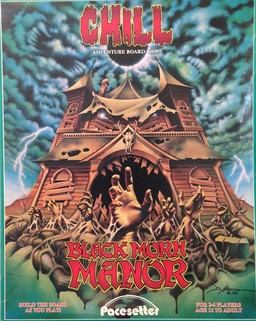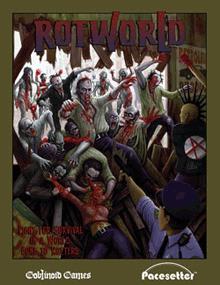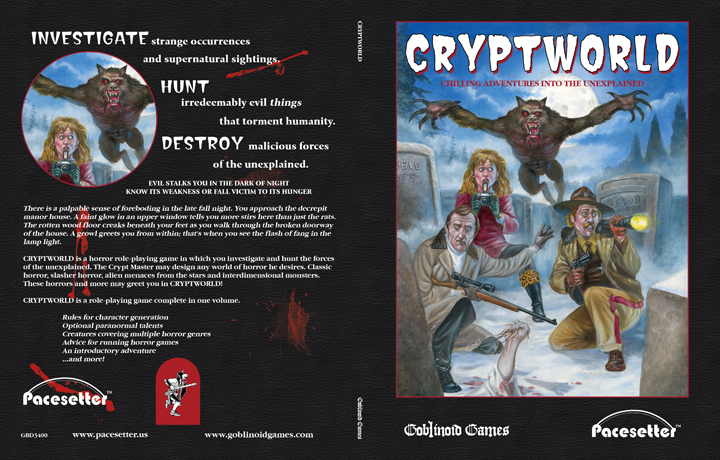A Return of Pacesetter RPG Style Horror
You are about to enter the world of CHILL, where unknown things sneak, and crawl, and creep, and slither in the darkness of a moonless night. This is the world of horror, the world of the vampire, ghost, and ghoul, the world of things not known, and best not dreamt of. CHILL is a role-playing game of adventure into the Unknown and your first adventure is about to begin — CHILL Introductory Folder
 In 1984, a group of former TSR Employees that included Mark Acres, Troy Denning, and Stephen Sullivan formed Pacesetter Ltd. Games and ambitiously published four role playing games: Chill, Timemaster, Star Ace, and Sandman. The rights to these games now belong to a diverse list of small publishers. Phil Reed owns the rights to Star Ace, Goblinoid Games own the rights to Timemaster and Sandman (as well as the Pacesetter brand), and Mayfair Games owns the rights to Chill.
In 1984, a group of former TSR Employees that included Mark Acres, Troy Denning, and Stephen Sullivan formed Pacesetter Ltd. Games and ambitiously published four role playing games: Chill, Timemaster, Star Ace, and Sandman. The rights to these games now belong to a diverse list of small publishers. Phil Reed owns the rights to Star Ace, Goblinoid Games own the rights to Timemaster and Sandman (as well as the Pacesetter brand), and Mayfair Games owns the rights to Chill.
Chill wasn’t the first horror role playing game, nor is it considered the best by the majority of gamers. However, it has long held a place as a “cult” favorite in the role playing game world. While it is a cult favorite, that cult status has not enabled it to garner a reprint in recent years. In 2009, Otherworld Creations attempted to do a Fundable campaign (a Kickstarter before Kickstarter was cool) and failed to raise the necessary money to do a new edition.
Chill was different from other horror role playing games that often sought to capture the dark nihilistic material horror of H.P. Lovecraft or turned monster-hunting into an action movie. Chill tried to capture the tone of Hammer and AIP productions. Because of this four-color focus, and I believe also because its creators were former TSR employees, Rick Swan reviewed the game quite negatively in Dragon magazine and in his Complete Guide to Role-Playing Games. Swan wrote that the game was:
A horror game for the easily frightened… While most of Chill‘s vampires, werewolves, and other B-movie refugees wouldn’t scare a ten-year-old, they’re appropriate to the modest ambitions of the game… Chill is too shallow for extended campaigns, and lacks the depth to please anyone but the most undemanding players. For beginners only.
 Swan was correct in describing the game as simple, and as appropriate for beginners, but he was wrong when he claimed that it lacked depth that could appeal to demanding players who want extended campaigns. The game has solid underlying mechanics that encourage a loose style of play that encourages storytelling over combat and reduces the dependency on die rolls that so many role playing games often overly promote.
Swan was correct in describing the game as simple, and as appropriate for beginners, but he was wrong when he claimed that it lacked depth that could appeal to demanding players who want extended campaigns. The game has solid underlying mechanics that encourage a loose style of play that encourages storytelling over combat and reduces the dependency on die rolls that so many role playing games often overly promote.
Like many Pacesetter games, Chill is innovative and slightly ahead of its time — nowhere is this more the case than with their Chill: Black Morn Manor board game — but like many things ahead of their time, there are some flaws to the mechanics.
Nothing too big, but definitely things that might make some gamers reject it out of hand. The game is simple enough that a group of players can pick up the rules and start to play within 15 minutes… from scratch.
This feature bears repeating. This game is easy enough to learn that a group can open the box and begin playing within fifteen minutes. Given how complex roleplaying games seem to the non-gamer, this is quite an achievement in and of itself.
The most comprehensive review of Chill was the review in Space Gamer 75 by Warren Spector. In the article, Spector provided a balanced review. Spector described the game as follows:
You won’t find better, more consistently entertaining writing in any set of game rules…
Chill is the first to include an introductory folder advising players to begin playing that adventure before they’ve read the rules of the game! To begin, players have only to read a four page READ-ME-FIRST! introduction to the rules, pick up the 16-page adventure booklet and begin playing! And, sure enough, the cockamamie scheme works!
There are many games from the 80s that — mechanically and tonally — seem extremely dated by modern gaming standards. Chill — the first Pacesetter edition — isn’t one of them. It has a kind of classic feel to it, just like all the Hammer and AIP movies it was inspired by. It isn’t a dark and serious horror game, but it is an adventurous one. If you wanted to pretend to be Peter Cushing’s Van Helsing hunting Christopher Lee’s Dracula, there was no better game than Chill during the early Pacesetter era. The later Mayfair game never captured the charm of the original and for a time it looked like fans of non-Lovecraftian horror were going to be left without a high quality horror RPG.
PACESETTER HORROR RISES FROM THE ASHES
“The air is crisp as autumn settles in, and the breeze is scented with burning leaves and pumpkin pie. Nights become longer and colder, and my imagination starts to question the sources of the bumps in the night.” — Dan Proctor from the forward to CRYPTWORLD.
Goblinoid Games has resurrected Pacesetter style horror just in time for Halloween with CRYPTWORLD. This game is the latest in Goblinoid’s Pacesetter line of games. The company cannot use the Chill name, as that belongs to Mayfair Games, but they have turned what could have been a drawback into a strength.
CRYPTWORLD brings the rules and some of the thematic elements that made Chill successful and updates them to include elements of the horror movies of the 1980s…a film era as far removed from today as the Hammer movies of the 60s were from 1984. Daniel Proctor has hired Jim Holloway, the cover artist of the original Chill, to illustrate the cover and provide a full page illustration on the inside cover. These illustrations demonstrate that the game has a tone similar to that of Chill, but also highlight how CRYPTWORLD is more than a sequel… it is a successor.
Where Chill was a game that was played best when simulating the horror of the Hammer Films, any kind of horror is possible with CRYPTWORLD. According to Dan Proctor,
CRYPTWORLD covers all of the important bases that Chill covered, but CRYPTWORLD [is] mostly inspired by horror movies from the 1980s. You can do Hammer Horror just fine, but you can also do Lost Boys, They Live, Friday the 13th, Nightmare on Elm Street, and so much more.
In the same way that 1980s films like Fright Night re-imagined classic horror by bringing classic stories into the modern era, CRYPTWORLD uses the Pacesetter engine to bring a new brand of classic horror to the gaming table. Here’s Dan again:
CRYPTWORLD goes well beyond [Chill] and handles many more subgenres of horror. It is a more complete presentation of horror rules, game advice, and creatures from different horror subgenres so that you can play any kind of horror game you prefer. Your characters can be members of one of the several example organizations that investigate the unexplained, rather than be limited to only one organization (i.e. S.A.V.E.). This also means that there is no specific assumed game setting.
 One of ways that the game expands on Chill concepts was in the inclusion of secret organizations that battle the supernatural. This was one of the features that made Chill so endearing to me, and so annoying to Rick Swan.
One of ways that the game expands on Chill concepts was in the inclusion of secret organizations that battle the supernatural. This was one of the features that made Chill so endearing to me, and so annoying to Rick Swan.
There are a number of secret societies included in the Crypt Master section. A personal favorite is the Smithsonian Institute’s Special Collections Division. The SCD is an organization that tries to keep “Monkey’s Paws” and similar items out of the hands of the unsuspecting. The secret organizations section has enough kernels to run a very interesting horror campaign. CRYPTWORLD also provides advice for what happens when the Player Characters try to explain to your average NPC that there are supernatural things afoot.
When asked what it is that attracted him to the Pacesetter brand, Dan Proctor responded that
For a lot of people interested in old-school games there is a certain mystique surrounding Pacesetter. They were only in business for a few short years, but their creative input was extremely impressive. They had a lot of great concepts and a house game system that was so innovative for its time that it has held up to this very day.
I agree entirely. Goblinoid Games has done the gaming community a great service in preserving the Pacesetter brand and publishing new games using the old system. Their Majus RPG has a strong concept and Rotworld has a setting that should resonate well with fans of The Walking Dead. Fans of 80s horror or the television show Supernatural should find many hours of enjoyment playing CRYPTWORLD.
The Pacesetter system is easy to learn, but like those older games, CRYPTWORLD includes an introductory adventure entitled Red Eye that will have your players dreading their next late night flight.
Jerry felt little relief as he looked down at his arm. He knew what it meant to be bitten. — CRYPTWORLD Chapter 1.

Yeah, I was thinking a campaign similar to Supernatural or Warehouse 13 would fit in well with the game as you describe it. Sounds like fun!
I remember seeing the Chill advertisements in Dragon magazine back in the day. One especially memorable one is a hand coming up out of the ground a few inches from some Victorian British guy’s surprised face–really striking!
If I’m remembering correctly, Chaosium’s Call of Cthulhu stuff really took off not long after that, or around the same time. Chill became another forgotten soul in the graveyard of early RPGs and other games.
For the past couple of years Chill has been my Halloween game of choice, but this year I’m going to run my group through Red Eye. About half of my group are younger gamers who have only THE WOMAN IN BLACK in their Hammer reference catalog…something else I’ll have to change…and who cut their teeth watching 80s horror when their parents had it on.
I retain a number of Chill supplements, mostly from the Mayfair days. Even in diluted form there was something special and different about Chill.
[…] action films (Indiana Jones, James Bond), and westerns (Boot Hill). There were horror games (Chill, Beyond the Supernatural), post-apocalyptic survival games (Twilight 2000, Gamma World), games […]
[…] game focused on pirates, or science fiction, or the Bronze Age, or the Wild West, King Arthur, horror movies, the fall of Moria, the Federation, Middle Earth, Jack Vance’s Dying Earth, Judge […]
[…] their RPG line — as Christian Lindke RPG reported in his article for us last year, A Return of Pacesetter RPG Style Horror. Since then they’ve published nearly 40 adventure supplements, including updated reprints of […]